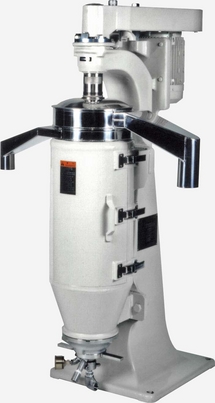 Tubular Centrifuges are designed to separate low percentages (<2%) of suspended solids which are between 1 and 0.001 microns in size, and to separate two immiscible liquids of differing densities. Tubular Centrifuges operate at high speed, generating up to 20,000 gravities of centrifugal force, causing solids to collect inside the smooth bore of the stainless steel tube where they are easily recovered. Tubular Centrifuges are an excellent replacement for many traditional filter and membrane applications due to their high efficiency (virtually no product loss) and small footprint. Additionally, unlike traditional filters, they never require pre-coating or back-flushing and can never clog. Tubular Centrifuges are designed to separate low percentages (<2%) of suspended solids which are between 1 and 0.001 microns in size, and to separate two immiscible liquids of differing densities. Tubular Centrifuges operate at high speed, generating up to 20,000 gravities of centrifugal force, causing solids to collect inside the smooth bore of the stainless steel tube where they are easily recovered. Tubular Centrifuges are an excellent replacement for many traditional filter and membrane applications due to their high efficiency (virtually no product loss) and small footprint. Additionally, unlike traditional filters, they never require pre-coating or back-flushing and can never clog.
Typical Applications
agglomerated proteins
aluminum silicate
animal cell fraction
antibiotics
bacteria
beta naphtholate
bio-fuel processing
biomass harvesting
bioremediation
blood fractionation
brewer’s yeasts
brine sludge
calcium carbonate
calcium sulphate
chromium hydroxide
cocoa butter clarification
cryoglobulin
cutting oil
dicalcium phosphate
dye stuffs
escherichia coli
electroplating solutions
enzyme harvesting
ethanol stillage
fat clarification
fermentation
fish oils
flavorings
food processing effluents
fruit juice clarification
fungus
gamma globulin
|
graphite
guanidine nitrate
gum arabic
herbal extracts
hydraulic oil
ink
insulin tissue
iron oxide
lactose
nano particles
paper mill effluent
pathogens
pharmaceuticals
pigments
polymers
precious metals
protein precipitate
prothrombin
refinery effluent
salicylic acid
sodium nitrite
sodium sulphate
spirillum
spore collection
tallow
titanium dioxide
varnish clarification
vegetable oil refining
virus recovery
wine clarification
yeast |
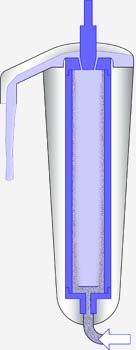 Solid-Liquid Separation Solid-Liquid Separation
OPERATION: Up to 20,000 gravities of centrifugal force cause suspended solids to migrate to the centrifuge tube wall where they are retained. As the fluid travels up through the tube, smaller solids eventually migrate to the wall and the clarified fluid is discharged through the top center of the tube.
FLOW: Fluid flow in and out of the centrifuge is continuous while the solids are collected on the tube wall in a batchwise manner. Flow rates may be as high as 700 gallons per hour depending on particle size, density and required separation efficiency.
SEPARATION EFFICIENCY: Solids capture of up to 99.9% is possible depending on product characteristics and flow rate.
SOLIDS HOLDING CAPACITY: Depending on centrifuge size, solids holding capacities range from 122 cubic inches (2 liters) to 1,525 cubic inches (25 liters). Solids holding capacities for each model of tubular centrifuge are listed on the back page.
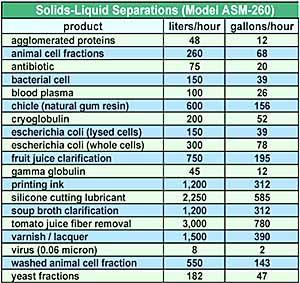
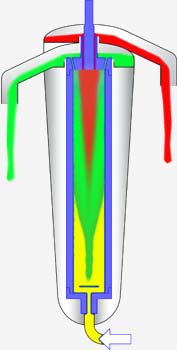 Liquid-Liquid Separation Liquid-Liquid Separation
OPERATION: Up to 20,000 gravities of force drive the heavier fluid toward the tube wall while the lighter fluid is displaced to the center of the tube.
FLOW: Fluid flow in and out of the centrifuge is continuous. In the illustration the heavier phase discharges through the left outlet and the lighter fluid discharges through the right outlet. If any solids are present they will be collected on the tube wall and may be removed periodically.
CAPACITY: Depending on the size of the centrifuge and fluid characteristics, flow rates over 1,000 gallons per hour are achievable.
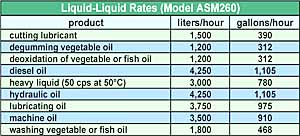
Design Options for both Solid-Liquid and Liquid-Liquid applications:
-
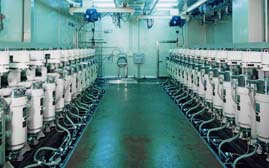 Pressure Design: Mechanical seals for operating pressures up to 28 psig. Pressure Design: Mechanical seals for operating pressures up to 28 psig.
-
Sanitary Construction for pharmaceuticals, biologics and food processing including tri-clamp connections, polished stainless steel housing and FDA approved elastomers.
-
High Temperature Design up to 662oF (350oC).
-
Sterilize-In-Place Designs.
-
Cooling: Coils may be mounted in the housing to control the temperature of the tube and fluids.
-
Rotating Housing or Full Opening Housing Designs (see next page) allow for easy tube removal, cleaning and inspection.
-
Electrical controls in NEMA-4 and 4X washdown and NEMA-7&9 for hazardous environments.
-
Skid Mounted and Portable Designs incorporating piping, pumps, instrumentation, holding tanks and controls.
-
Instrumentation available includes temperature, flow rate, pressure, oxygen analyzers, effluent clarity, colorimetry, particle analyzers and pH.
Application of Stokes’ Law to Tubular Centrifuges
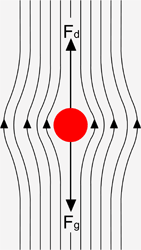 Stokes’ Law defines the settling rate of a particle in a fluid as the net effect of the drag on a particle versus the gravitational force acting on the particle. In a tubular centrifuge the gravitational force (g) is multiplied by 15,000 to 20,000 times. Settling rate is most affected by particle diameter (d2) and then by the difference in density between the solids and the fluid medium (pp- pf ). The variables of particle size and density differential are not easily controlled, but the remaining variable, viscosity (µ), can often be altered to increase separation performance. According to Stokes’ Law, halving the viscosity of the liquid will double the settling rate and, therefore, double the throughput of the tubular centrifuge. Viscosity can be reduced by increasing the temperature of the fluid or by direct dilution by the addition of a lower viscosity fluid. Stokes’ Law defines the settling rate of a particle in a fluid as the net effect of the drag on a particle versus the gravitational force acting on the particle. In a tubular centrifuge the gravitational force (g) is multiplied by 15,000 to 20,000 times. Settling rate is most affected by particle diameter (d2) and then by the difference in density between the solids and the fluid medium (pp- pf ). The variables of particle size and density differential are not easily controlled, but the remaining variable, viscosity (µ), can often be altered to increase separation performance. According to Stokes’ Law, halving the viscosity of the liquid will double the settling rate and, therefore, double the throughput of the tubular centrifuge. Viscosity can be reduced by increasing the temperature of the fluid or by direct dilution by the addition of a lower viscosity fluid.
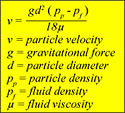
Download PDF - Tubular Centrifuge
|

